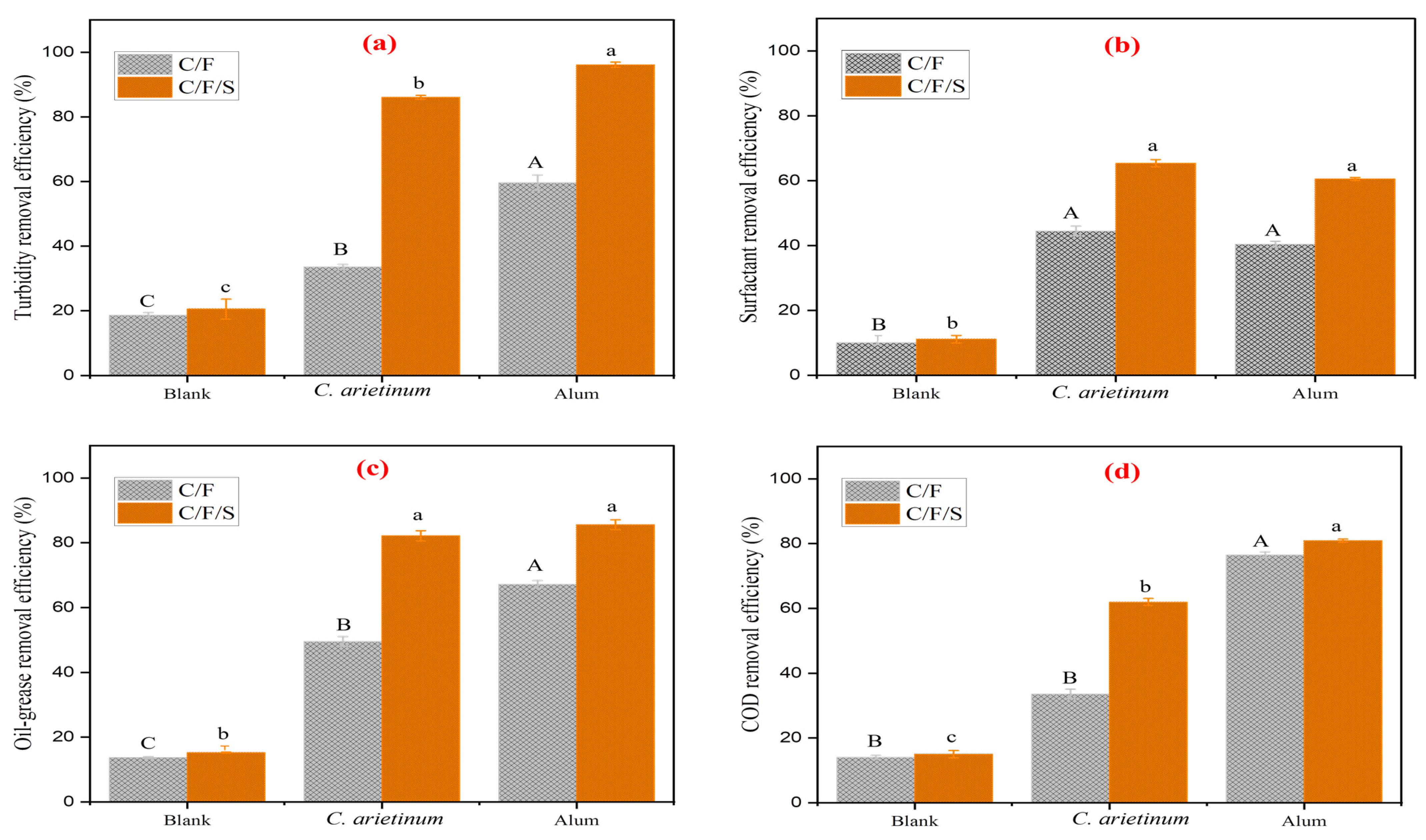Bench-Scale Continuous-Flow System for Coagulation/Flocculation/Sedimentation Treatment of Washing Bay Effluents: A Comparison between Natural and Chemical Coagulants †
Abstract
:1. Introduction
2. Materials and Methods
2.1. Effluent Collection and Characterization
2.2. Coagulant Materials and Choice of Optimal Dosage and pH
2.3. Continuous Feed Bench-Scale Studies
2.3.1. Design and Layout
2.3.2. System Set-Up
2.4. Performance Comparison and Prioritization of Coagulants
3. Results and Discussion
3.1. Treatment Performance of the Continuous Feed Bench-Scale System
3.2. pH Variation and Alkalinity Consumption
3.3. Aspects of Environmental Sustainability
3.4. Cost Evaluation Analysis
3.5. Selection of Best Coagulant
4. Conclusions
Supplementary Materials
Author Contributions
Funding
Institutional Review Board Statement
Informed Consent Statement
Data Availability Statement
Acknowledgments
Conflicts of Interest
References
- Veréb, G.; Gayır, V.E.; Santos, E.N.; Fazekas, Á.; Kertész, S.; Hodúr, C.; László, Z. Purification of Real Car Wash Wastewater with Complex Coagulation/Flocculation Methods Using Polyaluminum Chloride, Polyelectrolyte, Clay Mineral and Cationic Surfactant. Water Sci. Technol. 2020, 80, 1902–1909. [Google Scholar] [CrossRef] [PubMed]
- Priya, M.; Jeyanthi, J. Removal of COD, Oil and Grease from Automobile Wash Water Effluent Using Electrocoagulation Technique. Microchem. J. 2019, 150, 104070. [Google Scholar] [CrossRef]
- Dadebo, D.; Ibrahim, M.G.; Fujii, M.; Nasr, M. Transition towards Sustainable Carwash Wastewater Management: Trends and Enabling Technologies at Global Scale. Sustainability 2022, 14, 5652. [Google Scholar] [CrossRef]
- Veit, M.T.; Novais, Í.G.V.; Juchen, P.T.; Palácio, S.M.; Gonçalves, G.D.C.; Zanette, J.C. Automotive Wash Effluent Treatment Using Combined Process of Coagulation/Flocculation/Sedimentation–Adsorption. Water. Air. Soil Pollut. 2020, 231, 494. [Google Scholar] [CrossRef]
- Dadebo, D.; Nasr, M.; Fujii, M.; Ibrahim, M.G. Bio-Coagulation Using Cicer Arietinum Combined with Pyrolyzed Residual Sludge-Based Adsorption for Carwash Wastewater Treatment: A Techno-Economic and Sustainable Approach. J. Water Process Eng. 2022, 49, 103063. [Google Scholar] [CrossRef]
- Al-Gheethi, A.A.; Mohamed, R.M.S.R.; Rahman, M.A.A.; Johari, M.R.; Kassim, A.H.M. Treatment of Wastewater from Car Washes Using Natural Coagulation and Filtration System. IOP Conf. Ser. Mater. Sci. Eng. 2016, 136, 012046. [Google Scholar] [CrossRef]
- Suarez, S.; Lema, J.M.; Omil, F. Pre-Treatment of Hospital Wastewater by Coagulation-Flocculation and Flotation. Bioresour. Technol. 2009, 100, 2138–2146. [Google Scholar] [CrossRef] [PubMed]
- APHA. Standard Methods for Examination of Water and Wastewater, 21st ed.; American Public Health Association/American Water Works Association/Water Environment Federation: Washington, DC, USA, 2005. [Google Scholar]
- Tzeng, G.-H.; Huang, J.-J. Multiple Attribute Decision Making Methods and Applications; Chapman and Hall/CRC: New York, NY, USA, 2011. [Google Scholar]
- MWRI. Environmental Pollution and Legislative Regulations. Available online: https://www.mwri.gov.eg (accessed on 1 May 2021).
- Bhatti, Z.A.; Mahmood, Q.; Raja, I.A.; Malik, A.H.; Khan, M.S.; Wu, D. Chemical Oxidation of Carwash Industry Wastewater as an Effort to Decrease Water Pollution. Phys. Chem. Earth 2011, 36, 465–469. [Google Scholar] [CrossRef]
- Andrade, P.V.; Palanca, C.F.; de Oliveira, M.A.C.; Ito, C.Y.K.; dos Reis, A.G. Use of Moringa Oleifera Seed as a Natural Coagulant in Domestic Wastewater Tertiary Treatment: Physicochemical, Cytotoxicity and Bacterial Load Evaluation. J. Water Process Eng. 2021, 40, 101859. [Google Scholar] [CrossRef]

| Parameter | Real Wastewater | Maximum Limit a |
|---|---|---|
| pH | 8.1 ± 0.03 | 6–9 |
| Turbidity (NTU) | 159 ± 7.78 | 50 |
| COD (mg/L) | 216.67 ± 5.77 | 60 |
| Oil and grease (mg/L) | 59.4 ± 1.52 | 5 |
| Surfactants (mg/L) | 24.60 ± 1.25 | 0.5 |
| Alkalinity (mg/L as CaCO3) | 135 ± 5.42 | 20–150 |
| Aluminum (mg/L) | 0.089 ± 0.01 | <5 |
| n | Criteria | |||||
|---|---|---|---|---|---|---|
| C. arietinum | Alum | C. arietinum | Alum | |||
| 1 | Effectiveness on pollutant removal | 0.21 | 0.80 | 0.90 | 0.168 | 0.189 |
| 2 | Effect on pH reduction | 0.13 | 0.67 | 0.44 | 0.087 | 0.058 |
| 3 | Effect on alkalinity consumption | 0.11 | 1.00 | 0.40 | 0.110 | 0.044 |
| 4 | Volume of deposited sludge | 0.14 | 0.80 | 0.44 | 0.112 | 0.062 |
| 5 | Presence of residual aluminum in water | 0.12 | 1.00 | 0.40 | 0.120 | 0.048 |
| 6 | Sludge biodegradability | 0.14 | 1.00 | 0.40 | 0.140 | 0.056 |
| 7 | Material costs | 0.15 | 0.44 | 0.50 | 0.067 | 0.075 |
| 1 | 0.803 | 0.532 | ||||
Disclaimer/Publisher’s Note: The statements, opinions and data contained in all publications are solely those of the individual author(s) and contributor(s) and not of MDPI and/or the editor(s). MDPI and/or the editor(s) disclaim responsibility for any injury to people or property resulting from any ideas, methods, instructions or products referred to in the content. |
© 2023 by the authors. Licensee MDPI, Basel, Switzerland. This article is an open access article distributed under the terms and conditions of the Creative Commons Attribution (CC BY) license (https://creativecommons.org/licenses/by/4.0/).
Share and Cite
Dadebo, D.; Nasr, M.; Fujii, M.; Ibrahim, M.G. Bench-Scale Continuous-Flow System for Coagulation/Flocculation/Sedimentation Treatment of Washing Bay Effluents: A Comparison between Natural and Chemical Coagulants. Eng. Proc. 2023, 37, 79. https://doi.org/10.3390/ECP2023-14693
Dadebo D, Nasr M, Fujii M, Ibrahim MG. Bench-Scale Continuous-Flow System for Coagulation/Flocculation/Sedimentation Treatment of Washing Bay Effluents: A Comparison between Natural and Chemical Coagulants. Engineering Proceedings. 2023; 37(1):79. https://doi.org/10.3390/ECP2023-14693
Chicago/Turabian StyleDadebo, Derrick, Mahmoud Nasr, Manabu Fujii, and Mona G. Ibrahim. 2023. "Bench-Scale Continuous-Flow System for Coagulation/Flocculation/Sedimentation Treatment of Washing Bay Effluents: A Comparison between Natural and Chemical Coagulants" Engineering Proceedings 37, no. 1: 79. https://doi.org/10.3390/ECP2023-14693
APA StyleDadebo, D., Nasr, M., Fujii, M., & Ibrahim, M. G. (2023). Bench-Scale Continuous-Flow System for Coagulation/Flocculation/Sedimentation Treatment of Washing Bay Effluents: A Comparison between Natural and Chemical Coagulants. Engineering Proceedings, 37(1), 79. https://doi.org/10.3390/ECP2023-14693









